Sony's International Strategy: A Critical Evaluation of Market Entry
VerifiedAdded on 2023/05/29
|12
|3446
|228
Essay
AI Summary
This essay provides a critical evaluation of Sony's strategy and international management, focusing on its entry into the Indian market. It begins by highlighting the importance of strategy and international management, followed by a brief overview of Sony's history and establishment. The essay then discusses the motives behind Sony's internationalization, including market opportunities and risk diversification, and examines the role of foreign direct investment (FDI). It analyzes Sony's generic strategy of differentiation for gaining competitive advantage and explores its market penetration, product development, and market development strategies. The challenges faced by Sony in the Indian market, such as price sensitivity and intense competition, are also addressed. Furthermore, the essay evaluates the external factors influencing Sony's business environment using Porter's five forces analysis and PESTEL analysis, examining aspects such as competitive rivalry, bargaining power of customers and suppliers, threat of substitutes, and new entrants. The essay concludes by summarizing Sony's contributions and developments in the international market.
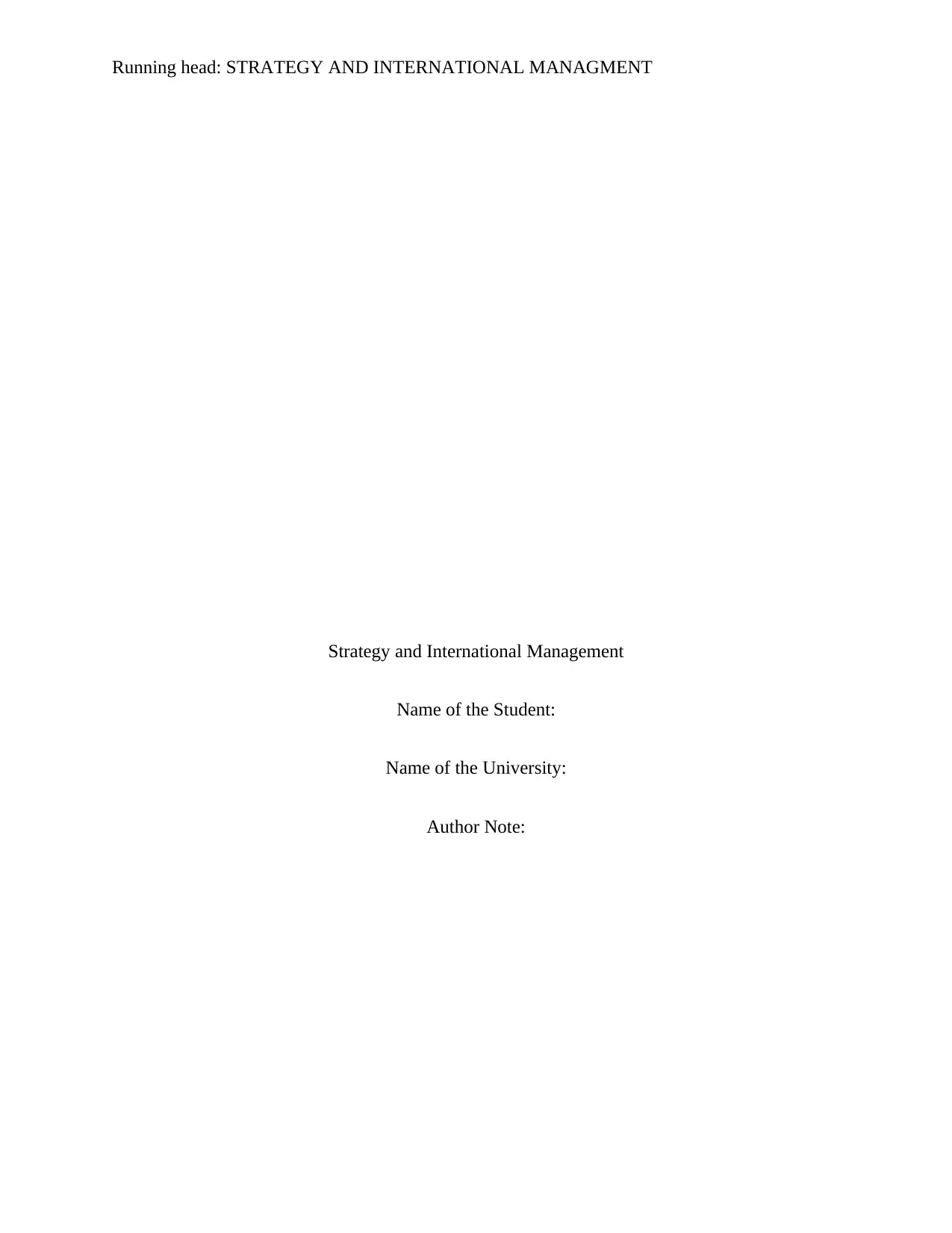
Running head: STRATEGY AND INTERNATIONAL MANAGMENT
Strategy and International Management
Name of the Student:
Name of the University:
Author Note:
Strategy and International Management
Name of the Student:
Name of the University:
Author Note:
Paraphrase This Document
Need a fresh take? Get an instant paraphrase of this document with our AI Paraphraser
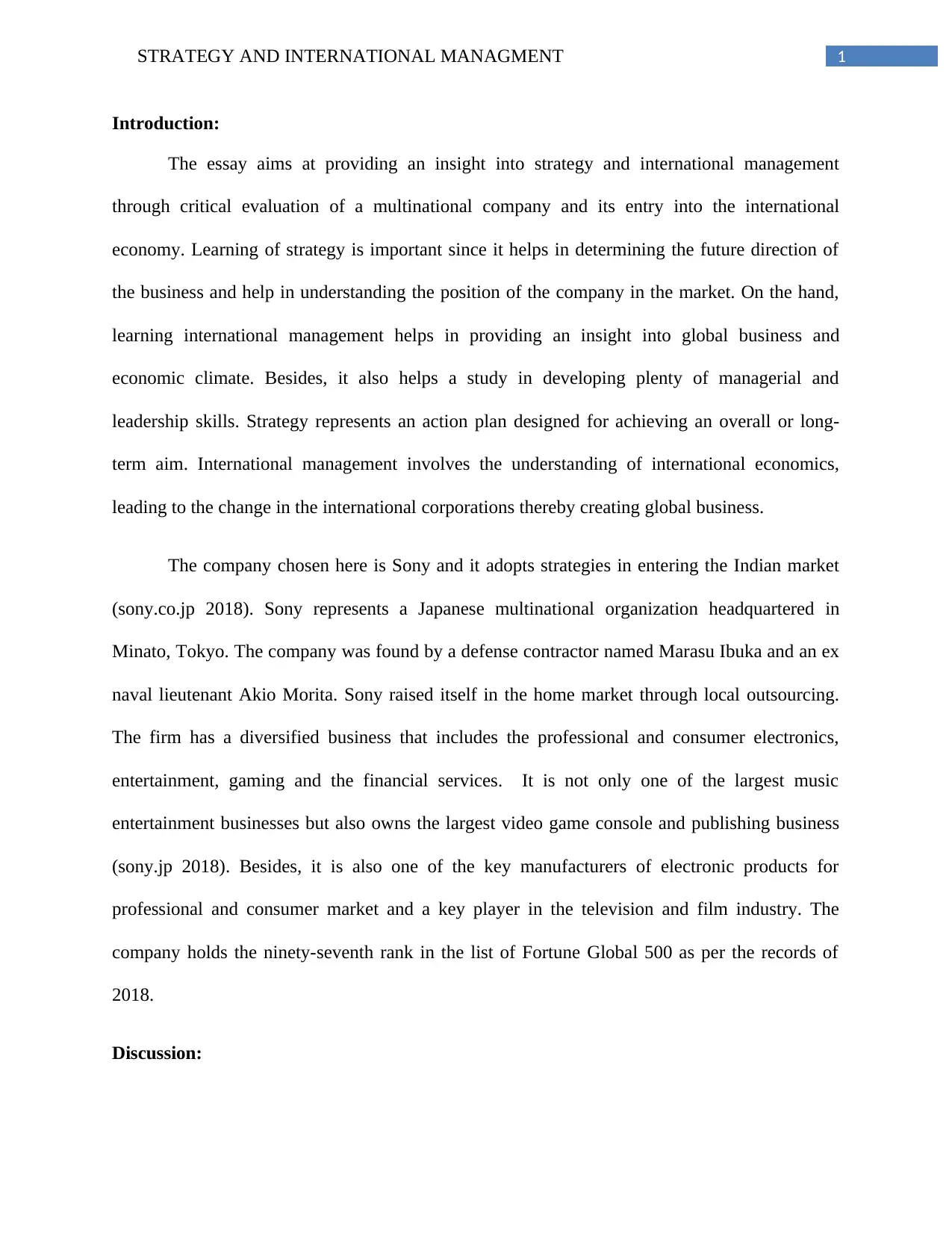
1STRATEGY AND INTERNATIONAL MANAGMENT
Introduction:
The essay aims at providing an insight into strategy and international management
through critical evaluation of a multinational company and its entry into the international
economy. Learning of strategy is important since it helps in determining the future direction of
the business and help in understanding the position of the company in the market. On the hand,
learning international management helps in providing an insight into global business and
economic climate. Besides, it also helps a study in developing plenty of managerial and
leadership skills. Strategy represents an action plan designed for achieving an overall or long-
term aim. International management involves the understanding of international economics,
leading to the change in the international corporations thereby creating global business.
The company chosen here is Sony and it adopts strategies in entering the Indian market
(sony.co.jp 2018). Sony represents a Japanese multinational organization headquartered in
Minato, Tokyo. The company was found by a defense contractor named Marasu Ibuka and an ex
naval lieutenant Akio Morita. Sony raised itself in the home market through local outsourcing.
The firm has a diversified business that includes the professional and consumer electronics,
entertainment, gaming and the financial services. It is not only one of the largest music
entertainment businesses but also owns the largest video game console and publishing business
(sony.jp 2018). Besides, it is also one of the key manufacturers of electronic products for
professional and consumer market and a key player in the television and film industry. The
company holds the ninety-seventh rank in the list of Fortune Global 500 as per the records of
2018.
Discussion:
Introduction:
The essay aims at providing an insight into strategy and international management
through critical evaluation of a multinational company and its entry into the international
economy. Learning of strategy is important since it helps in determining the future direction of
the business and help in understanding the position of the company in the market. On the hand,
learning international management helps in providing an insight into global business and
economic climate. Besides, it also helps a study in developing plenty of managerial and
leadership skills. Strategy represents an action plan designed for achieving an overall or long-
term aim. International management involves the understanding of international economics,
leading to the change in the international corporations thereby creating global business.
The company chosen here is Sony and it adopts strategies in entering the Indian market
(sony.co.jp 2018). Sony represents a Japanese multinational organization headquartered in
Minato, Tokyo. The company was found by a defense contractor named Marasu Ibuka and an ex
naval lieutenant Akio Morita. Sony raised itself in the home market through local outsourcing.
The firm has a diversified business that includes the professional and consumer electronics,
entertainment, gaming and the financial services. It is not only one of the largest music
entertainment businesses but also owns the largest video game console and publishing business
(sony.jp 2018). Besides, it is also one of the key manufacturers of electronic products for
professional and consumer market and a key player in the television and film industry. The
company holds the ninety-seventh rank in the list of Fortune Global 500 as per the records of
2018.
Discussion:
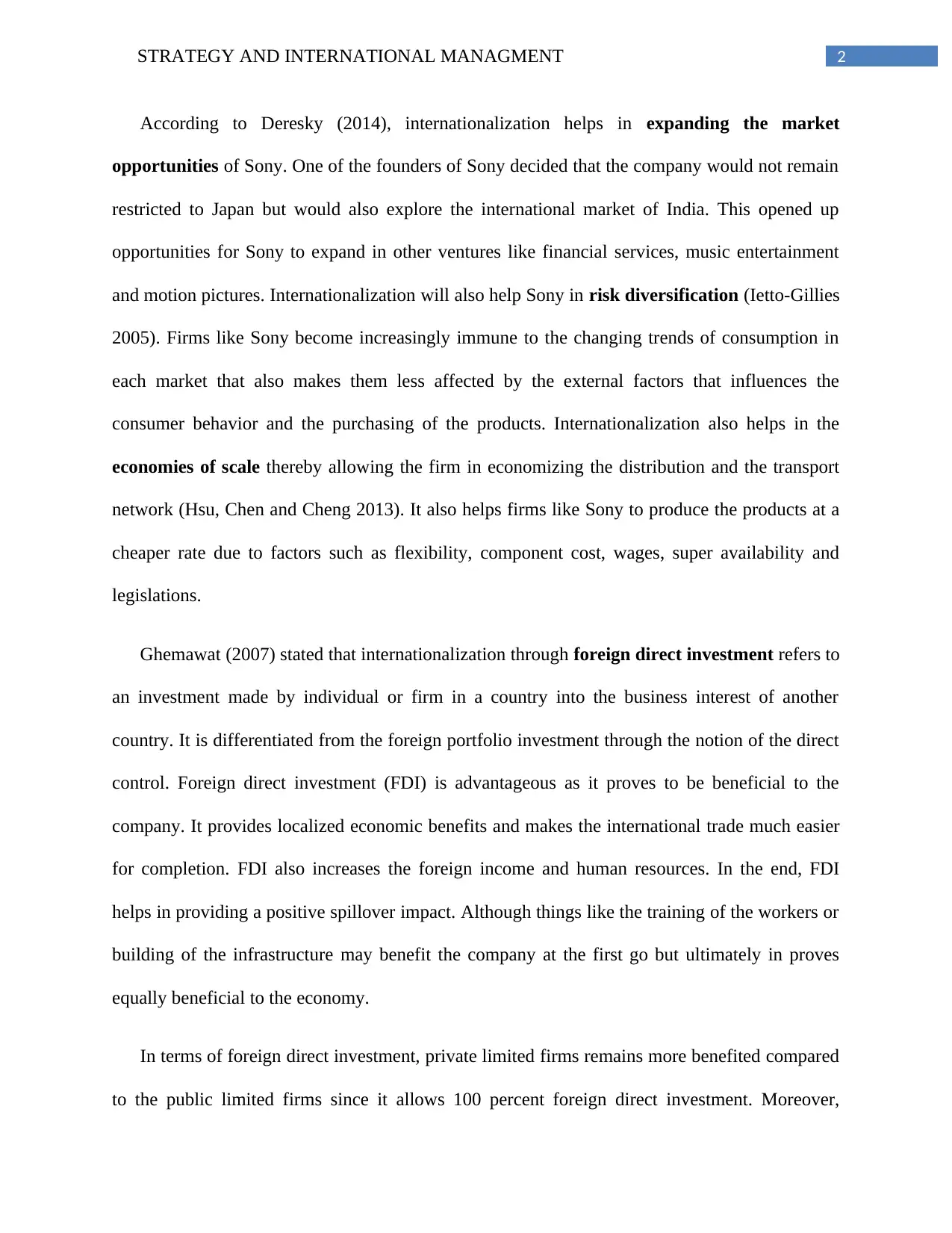
2STRATEGY AND INTERNATIONAL MANAGMENT
According to Deresky (2014), internationalization helps in expanding the market
opportunities of Sony. One of the founders of Sony decided that the company would not remain
restricted to Japan but would also explore the international market of India. This opened up
opportunities for Sony to expand in other ventures like financial services, music entertainment
and motion pictures. Internationalization will also help Sony in risk diversification (Ietto-Gillies
2005). Firms like Sony become increasingly immune to the changing trends of consumption in
each market that also makes them less affected by the external factors that influences the
consumer behavior and the purchasing of the products. Internationalization also helps in the
economies of scale thereby allowing the firm in economizing the distribution and the transport
network (Hsu, Chen and Cheng 2013). It also helps firms like Sony to produce the products at a
cheaper rate due to factors such as flexibility, component cost, wages, super availability and
legislations.
Ghemawat (2007) stated that internationalization through foreign direct investment refers to
an investment made by individual or firm in a country into the business interest of another
country. It is differentiated from the foreign portfolio investment through the notion of the direct
control. Foreign direct investment (FDI) is advantageous as it proves to be beneficial to the
company. It provides localized economic benefits and makes the international trade much easier
for completion. FDI also increases the foreign income and human resources. In the end, FDI
helps in providing a positive spillover impact. Although things like the training of the workers or
building of the infrastructure may benefit the company at the first go but ultimately in proves
equally beneficial to the economy.
In terms of foreign direct investment, private limited firms remains more benefited compared
to the public limited firms since it allows 100 percent foreign direct investment. Moreover,
According to Deresky (2014), internationalization helps in expanding the market
opportunities of Sony. One of the founders of Sony decided that the company would not remain
restricted to Japan but would also explore the international market of India. This opened up
opportunities for Sony to expand in other ventures like financial services, music entertainment
and motion pictures. Internationalization will also help Sony in risk diversification (Ietto-Gillies
2005). Firms like Sony become increasingly immune to the changing trends of consumption in
each market that also makes them less affected by the external factors that influences the
consumer behavior and the purchasing of the products. Internationalization also helps in the
economies of scale thereby allowing the firm in economizing the distribution and the transport
network (Hsu, Chen and Cheng 2013). It also helps firms like Sony to produce the products at a
cheaper rate due to factors such as flexibility, component cost, wages, super availability and
legislations.
Ghemawat (2007) stated that internationalization through foreign direct investment refers to
an investment made by individual or firm in a country into the business interest of another
country. It is differentiated from the foreign portfolio investment through the notion of the direct
control. Foreign direct investment (FDI) is advantageous as it proves to be beneficial to the
company. It provides localized economic benefits and makes the international trade much easier
for completion. FDI also increases the foreign income and human resources. In the end, FDI
helps in providing a positive spillover impact. Although things like the training of the workers or
building of the infrastructure may benefit the company at the first go but ultimately in proves
equally beneficial to the economy.
In terms of foreign direct investment, private limited firms remains more benefited compared
to the public limited firms since it allows 100 percent foreign direct investment. Moreover,
⊘ This is a preview!⊘
Do you want full access?
Subscribe today to unlock all pages.

Trusted by 1+ million students worldwide
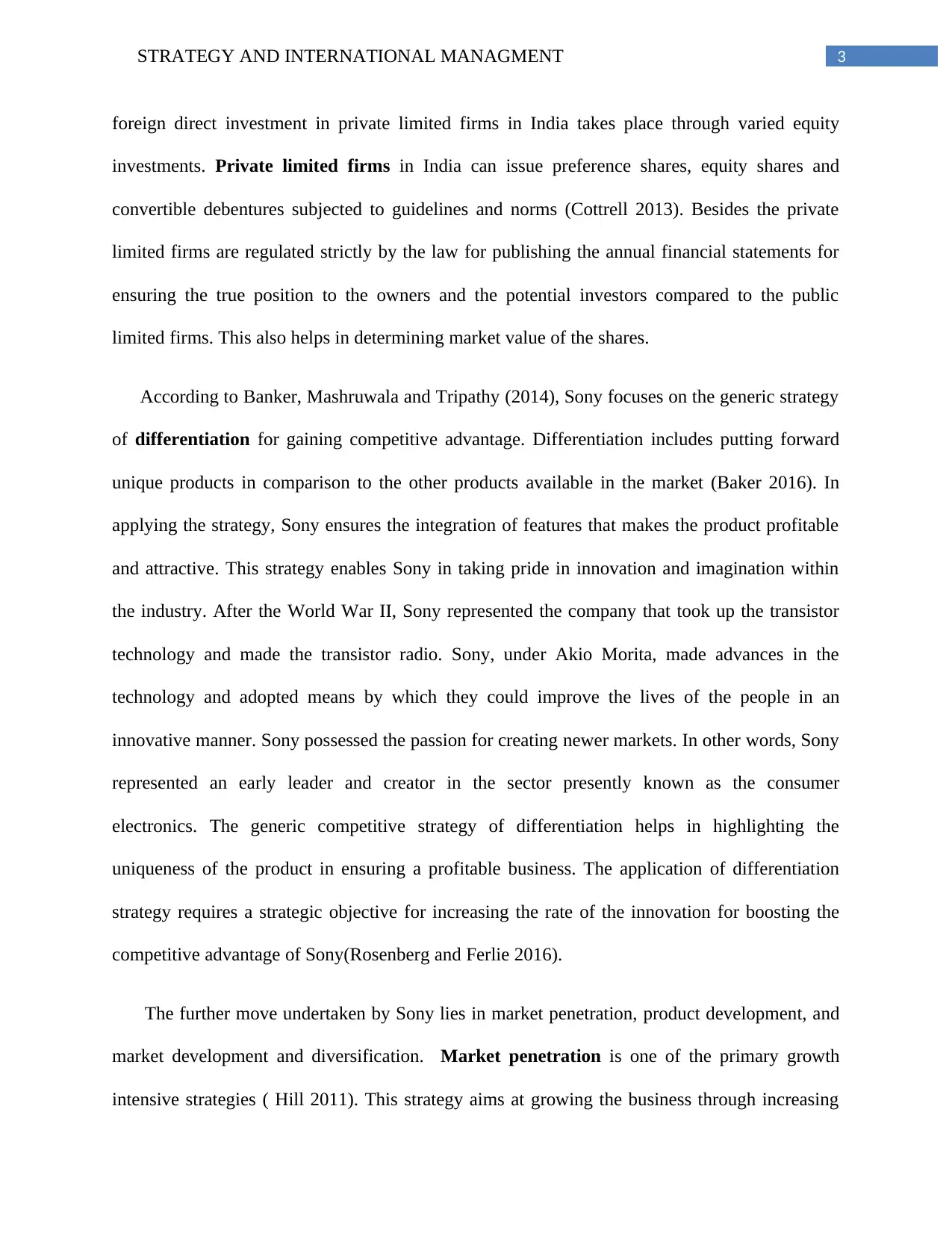
3STRATEGY AND INTERNATIONAL MANAGMENT
foreign direct investment in private limited firms in India takes place through varied equity
investments. Private limited firms in India can issue preference shares, equity shares and
convertible debentures subjected to guidelines and norms (Cottrell 2013). Besides the private
limited firms are regulated strictly by the law for publishing the annual financial statements for
ensuring the true position to the owners and the potential investors compared to the public
limited firms. This also helps in determining market value of the shares.
According to Banker, Mashruwala and Tripathy (2014), Sony focuses on the generic strategy
of differentiation for gaining competitive advantage. Differentiation includes putting forward
unique products in comparison to the other products available in the market (Baker 2016). In
applying the strategy, Sony ensures the integration of features that makes the product profitable
and attractive. This strategy enables Sony in taking pride in innovation and imagination within
the industry. After the World War II, Sony represented the company that took up the transistor
technology and made the transistor radio. Sony, under Akio Morita, made advances in the
technology and adopted means by which they could improve the lives of the people in an
innovative manner. Sony possessed the passion for creating newer markets. In other words, Sony
represented an early leader and creator in the sector presently known as the consumer
electronics. The generic competitive strategy of differentiation helps in highlighting the
uniqueness of the product in ensuring a profitable business. The application of differentiation
strategy requires a strategic objective for increasing the rate of the innovation for boosting the
competitive advantage of Sony(Rosenberg and Ferlie 2016).
The further move undertaken by Sony lies in market penetration, product development, and
market development and diversification. Market penetration is one of the primary growth
intensive strategies ( Hill 2011). This strategy aims at growing the business through increasing
foreign direct investment in private limited firms in India takes place through varied equity
investments. Private limited firms in India can issue preference shares, equity shares and
convertible debentures subjected to guidelines and norms (Cottrell 2013). Besides the private
limited firms are regulated strictly by the law for publishing the annual financial statements for
ensuring the true position to the owners and the potential investors compared to the public
limited firms. This also helps in determining market value of the shares.
According to Banker, Mashruwala and Tripathy (2014), Sony focuses on the generic strategy
of differentiation for gaining competitive advantage. Differentiation includes putting forward
unique products in comparison to the other products available in the market (Baker 2016). In
applying the strategy, Sony ensures the integration of features that makes the product profitable
and attractive. This strategy enables Sony in taking pride in innovation and imagination within
the industry. After the World War II, Sony represented the company that took up the transistor
technology and made the transistor radio. Sony, under Akio Morita, made advances in the
technology and adopted means by which they could improve the lives of the people in an
innovative manner. Sony possessed the passion for creating newer markets. In other words, Sony
represented an early leader and creator in the sector presently known as the consumer
electronics. The generic competitive strategy of differentiation helps in highlighting the
uniqueness of the product in ensuring a profitable business. The application of differentiation
strategy requires a strategic objective for increasing the rate of the innovation for boosting the
competitive advantage of Sony(Rosenberg and Ferlie 2016).
The further move undertaken by Sony lies in market penetration, product development, and
market development and diversification. Market penetration is one of the primary growth
intensive strategies ( Hill 2011). This strategy aims at growing the business through increasing
Paraphrase This Document
Need a fresh take? Get an instant paraphrase of this document with our AI Paraphraser
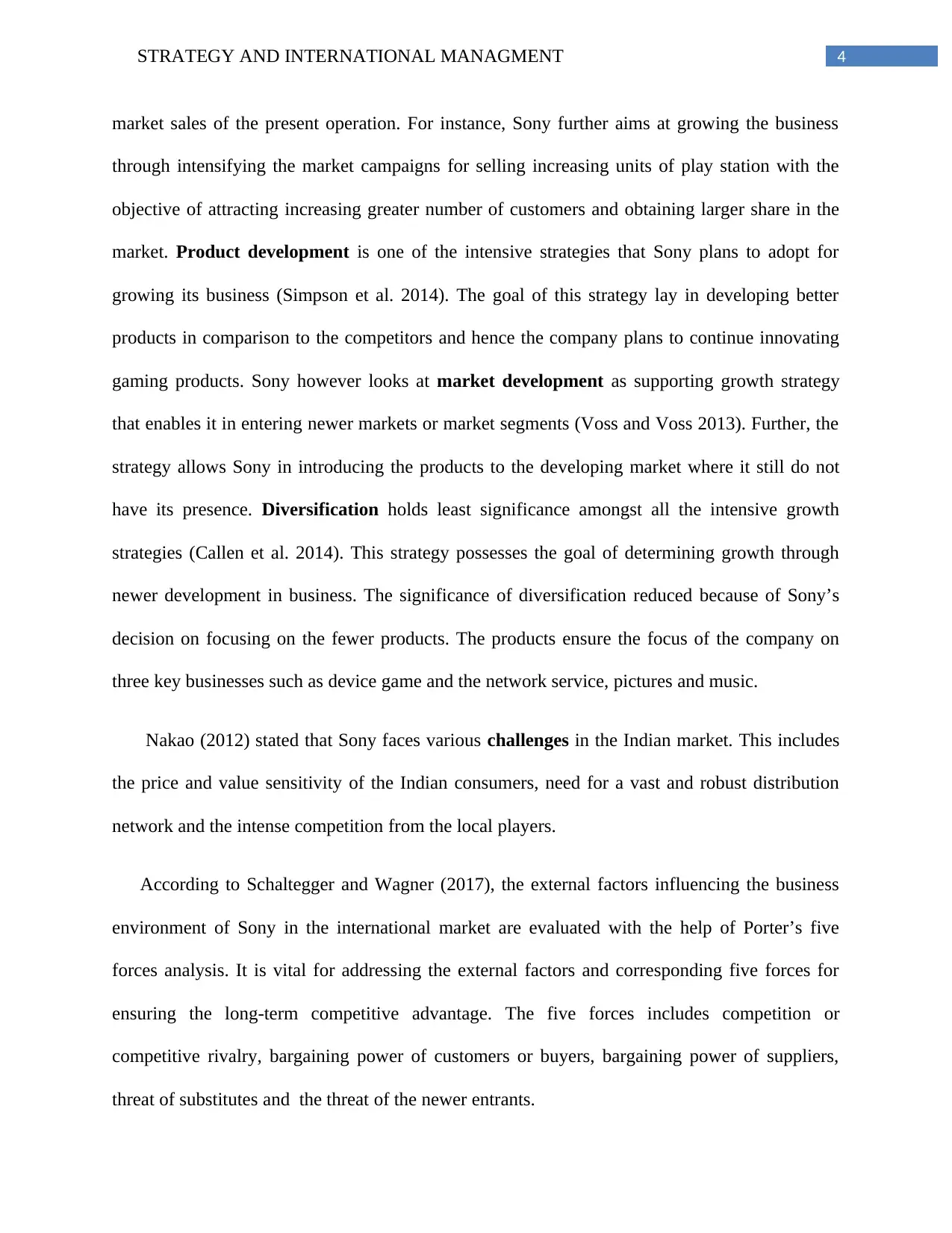
4STRATEGY AND INTERNATIONAL MANAGMENT
market sales of the present operation. For instance, Sony further aims at growing the business
through intensifying the market campaigns for selling increasing units of play station with the
objective of attracting increasing greater number of customers and obtaining larger share in the
market. Product development is one of the intensive strategies that Sony plans to adopt for
growing its business (Simpson et al. 2014). The goal of this strategy lay in developing better
products in comparison to the competitors and hence the company plans to continue innovating
gaming products. Sony however looks at market development as supporting growth strategy
that enables it in entering newer markets or market segments (Voss and Voss 2013). Further, the
strategy allows Sony in introducing the products to the developing market where it still do not
have its presence. Diversification holds least significance amongst all the intensive growth
strategies (Callen et al. 2014). This strategy possesses the goal of determining growth through
newer development in business. The significance of diversification reduced because of Sony’s
decision on focusing on the fewer products. The products ensure the focus of the company on
three key businesses such as device game and the network service, pictures and music.
Nakao (2012) stated that Sony faces various challenges in the Indian market. This includes
the price and value sensitivity of the Indian consumers, need for a vast and robust distribution
network and the intense competition from the local players.
According to Schaltegger and Wagner (2017), the external factors influencing the business
environment of Sony in the international market are evaluated with the help of Porter’s five
forces analysis. It is vital for addressing the external factors and corresponding five forces for
ensuring the long-term competitive advantage. The five forces includes competition or
competitive rivalry, bargaining power of customers or buyers, bargaining power of suppliers,
threat of substitutes and the threat of the newer entrants.
market sales of the present operation. For instance, Sony further aims at growing the business
through intensifying the market campaigns for selling increasing units of play station with the
objective of attracting increasing greater number of customers and obtaining larger share in the
market. Product development is one of the intensive strategies that Sony plans to adopt for
growing its business (Simpson et al. 2014). The goal of this strategy lay in developing better
products in comparison to the competitors and hence the company plans to continue innovating
gaming products. Sony however looks at market development as supporting growth strategy
that enables it in entering newer markets or market segments (Voss and Voss 2013). Further, the
strategy allows Sony in introducing the products to the developing market where it still do not
have its presence. Diversification holds least significance amongst all the intensive growth
strategies (Callen et al. 2014). This strategy possesses the goal of determining growth through
newer development in business. The significance of diversification reduced because of Sony’s
decision on focusing on the fewer products. The products ensure the focus of the company on
three key businesses such as device game and the network service, pictures and music.
Nakao (2012) stated that Sony faces various challenges in the Indian market. This includes
the price and value sensitivity of the Indian consumers, need for a vast and robust distribution
network and the intense competition from the local players.
According to Schaltegger and Wagner (2017), the external factors influencing the business
environment of Sony in the international market are evaluated with the help of Porter’s five
forces analysis. It is vital for addressing the external factors and corresponding five forces for
ensuring the long-term competitive advantage. The five forces includes competition or
competitive rivalry, bargaining power of customers or buyers, bargaining power of suppliers,
threat of substitutes and the threat of the newer entrants.
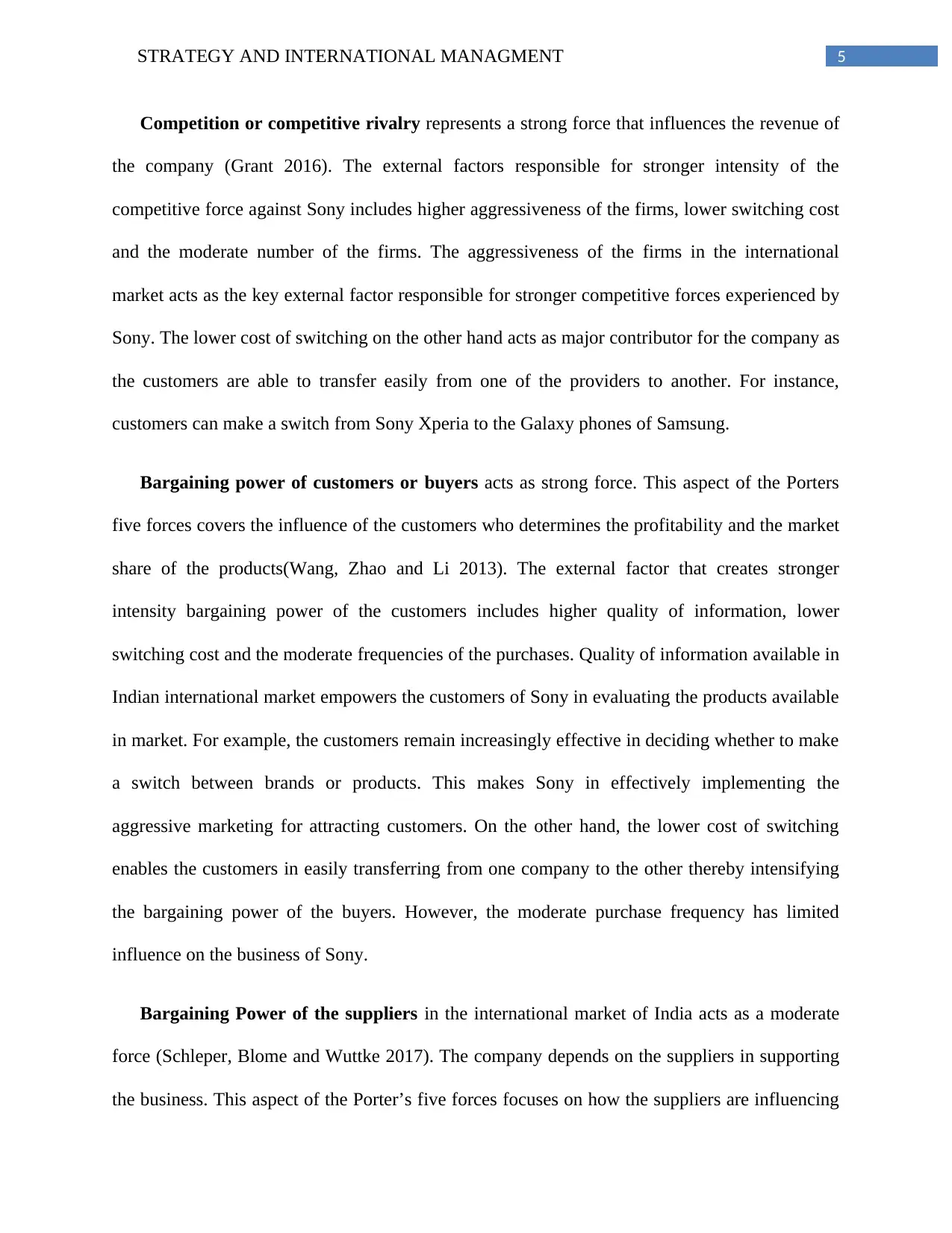
5STRATEGY AND INTERNATIONAL MANAGMENT
Competition or competitive rivalry represents a strong force that influences the revenue of
the company (Grant 2016). The external factors responsible for stronger intensity of the
competitive force against Sony includes higher aggressiveness of the firms, lower switching cost
and the moderate number of the firms. The aggressiveness of the firms in the international
market acts as the key external factor responsible for stronger competitive forces experienced by
Sony. The lower cost of switching on the other hand acts as major contributor for the company as
the customers are able to transfer easily from one of the providers to another. For instance,
customers can make a switch from Sony Xperia to the Galaxy phones of Samsung.
Bargaining power of customers or buyers acts as strong force. This aspect of the Porters
five forces covers the influence of the customers who determines the profitability and the market
share of the products(Wang, Zhao and Li 2013). The external factor that creates stronger
intensity bargaining power of the customers includes higher quality of information, lower
switching cost and the moderate frequencies of the purchases. Quality of information available in
Indian international market empowers the customers of Sony in evaluating the products available
in market. For example, the customers remain increasingly effective in deciding whether to make
a switch between brands or products. This makes Sony in effectively implementing the
aggressive marketing for attracting customers. On the other hand, the lower cost of switching
enables the customers in easily transferring from one company to the other thereby intensifying
the bargaining power of the buyers. However, the moderate purchase frequency has limited
influence on the business of Sony.
Bargaining Power of the suppliers in the international market of India acts as a moderate
force (Schleper, Blome and Wuttke 2017). The company depends on the suppliers in supporting
the business. This aspect of the Porter’s five forces focuses on how the suppliers are influencing
Competition or competitive rivalry represents a strong force that influences the revenue of
the company (Grant 2016). The external factors responsible for stronger intensity of the
competitive force against Sony includes higher aggressiveness of the firms, lower switching cost
and the moderate number of the firms. The aggressiveness of the firms in the international
market acts as the key external factor responsible for stronger competitive forces experienced by
Sony. The lower cost of switching on the other hand acts as major contributor for the company as
the customers are able to transfer easily from one of the providers to another. For instance,
customers can make a switch from Sony Xperia to the Galaxy phones of Samsung.
Bargaining power of customers or buyers acts as strong force. This aspect of the Porters
five forces covers the influence of the customers who determines the profitability and the market
share of the products(Wang, Zhao and Li 2013). The external factor that creates stronger
intensity bargaining power of the customers includes higher quality of information, lower
switching cost and the moderate frequencies of the purchases. Quality of information available in
Indian international market empowers the customers of Sony in evaluating the products available
in market. For example, the customers remain increasingly effective in deciding whether to make
a switch between brands or products. This makes Sony in effectively implementing the
aggressive marketing for attracting customers. On the other hand, the lower cost of switching
enables the customers in easily transferring from one company to the other thereby intensifying
the bargaining power of the buyers. However, the moderate purchase frequency has limited
influence on the business of Sony.
Bargaining Power of the suppliers in the international market of India acts as a moderate
force (Schleper, Blome and Wuttke 2017). The company depends on the suppliers in supporting
the business. This aspect of the Porter’s five forces focuses on how the suppliers are influencing
⊘ This is a preview!⊘
Do you want full access?
Subscribe today to unlock all pages.

Trusted by 1+ million students worldwide
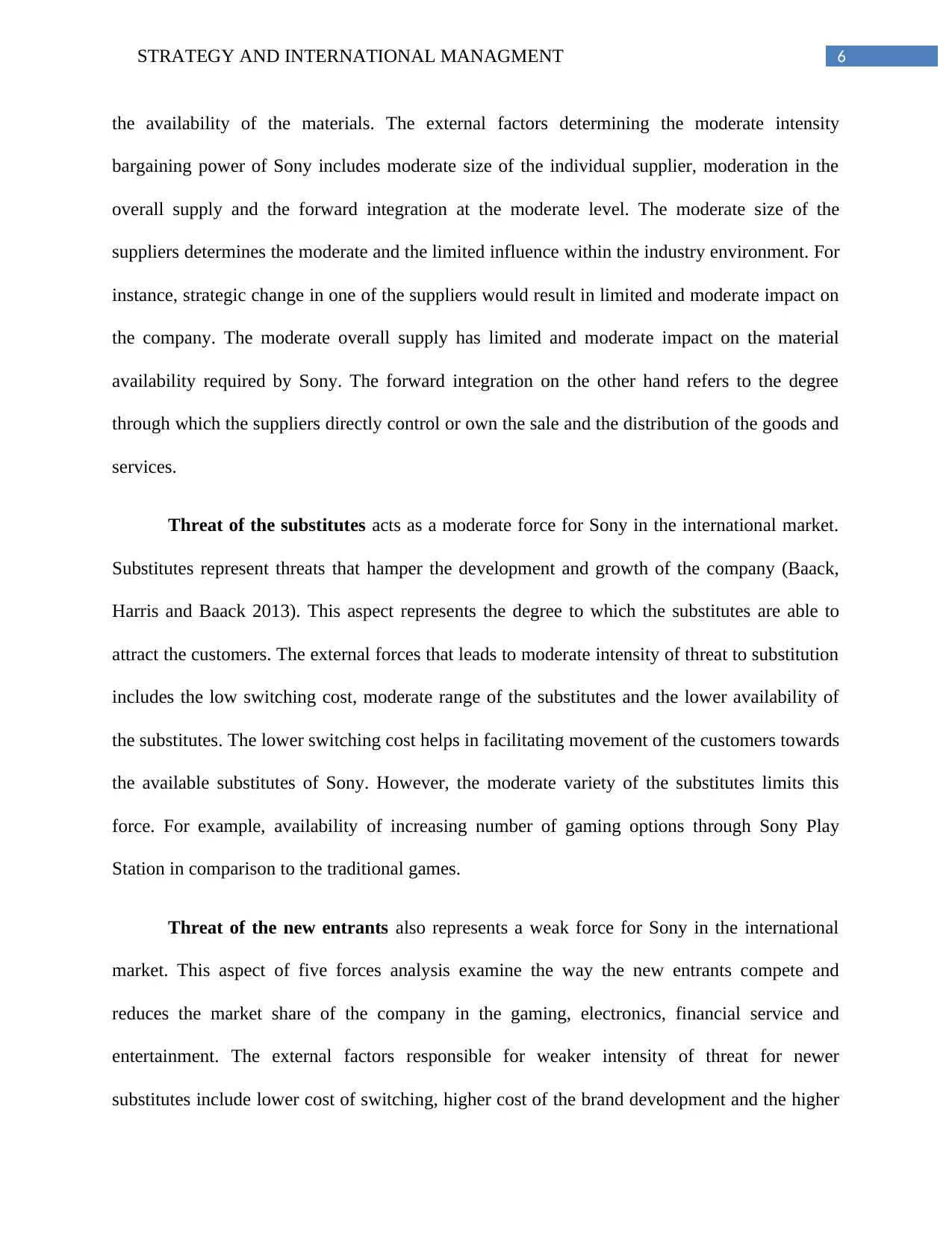
6STRATEGY AND INTERNATIONAL MANAGMENT
the availability of the materials. The external factors determining the moderate intensity
bargaining power of Sony includes moderate size of the individual supplier, moderation in the
overall supply and the forward integration at the moderate level. The moderate size of the
suppliers determines the moderate and the limited influence within the industry environment. For
instance, strategic change in one of the suppliers would result in limited and moderate impact on
the company. The moderate overall supply has limited and moderate impact on the material
availability required by Sony. The forward integration on the other hand refers to the degree
through which the suppliers directly control or own the sale and the distribution of the goods and
services.
Threat of the substitutes acts as a moderate force for Sony in the international market.
Substitutes represent threats that hamper the development and growth of the company (Baack,
Harris and Baack 2013). This aspect represents the degree to which the substitutes are able to
attract the customers. The external forces that leads to moderate intensity of threat to substitution
includes the low switching cost, moderate range of the substitutes and the lower availability of
the substitutes. The lower switching cost helps in facilitating movement of the customers towards
the available substitutes of Sony. However, the moderate variety of the substitutes limits this
force. For example, availability of increasing number of gaming options through Sony Play
Station in comparison to the traditional games.
Threat of the new entrants also represents a weak force for Sony in the international
market. This aspect of five forces analysis examine the way the new entrants compete and
reduces the market share of the company in the gaming, electronics, financial service and
entertainment. The external factors responsible for weaker intensity of threat for newer
substitutes include lower cost of switching, higher cost of the brand development and the higher
the availability of the materials. The external factors determining the moderate intensity
bargaining power of Sony includes moderate size of the individual supplier, moderation in the
overall supply and the forward integration at the moderate level. The moderate size of the
suppliers determines the moderate and the limited influence within the industry environment. For
instance, strategic change in one of the suppliers would result in limited and moderate impact on
the company. The moderate overall supply has limited and moderate impact on the material
availability required by Sony. The forward integration on the other hand refers to the degree
through which the suppliers directly control or own the sale and the distribution of the goods and
services.
Threat of the substitutes acts as a moderate force for Sony in the international market.
Substitutes represent threats that hamper the development and growth of the company (Baack,
Harris and Baack 2013). This aspect represents the degree to which the substitutes are able to
attract the customers. The external forces that leads to moderate intensity of threat to substitution
includes the low switching cost, moderate range of the substitutes and the lower availability of
the substitutes. The lower switching cost helps in facilitating movement of the customers towards
the available substitutes of Sony. However, the moderate variety of the substitutes limits this
force. For example, availability of increasing number of gaming options through Sony Play
Station in comparison to the traditional games.
Threat of the new entrants also represents a weak force for Sony in the international
market. This aspect of five forces analysis examine the way the new entrants compete and
reduces the market share of the company in the gaming, electronics, financial service and
entertainment. The external factors responsible for weaker intensity of threat for newer
substitutes include lower cost of switching, higher cost of the brand development and the higher
Paraphrase This Document
Need a fresh take? Get an instant paraphrase of this document with our AI Paraphraser
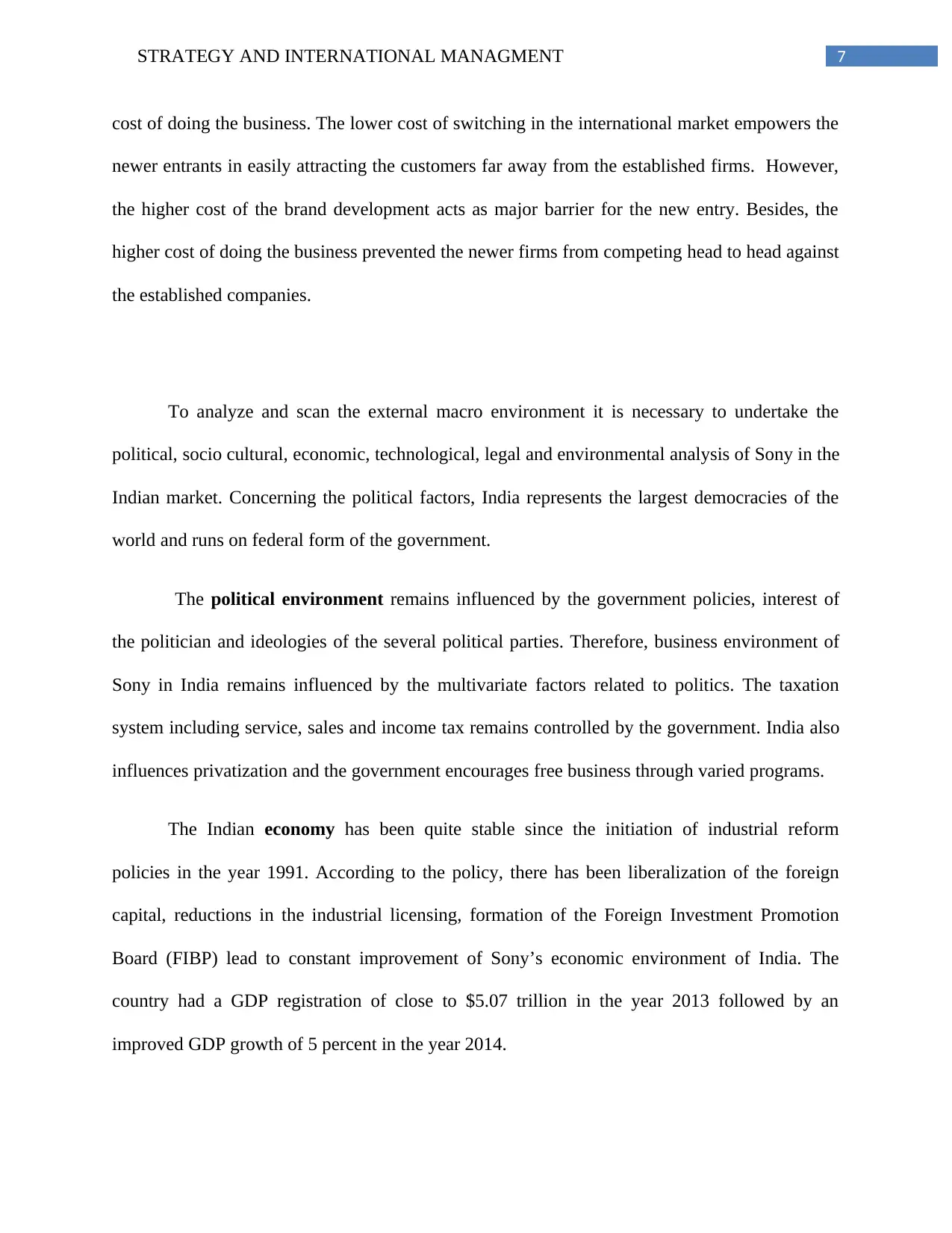
7STRATEGY AND INTERNATIONAL MANAGMENT
cost of doing the business. The lower cost of switching in the international market empowers the
newer entrants in easily attracting the customers far away from the established firms. However,
the higher cost of the brand development acts as major barrier for the new entry. Besides, the
higher cost of doing the business prevented the newer firms from competing head to head against
the established companies.
To analyze and scan the external macro environment it is necessary to undertake the
political, socio cultural, economic, technological, legal and environmental analysis of Sony in the
Indian market. Concerning the political factors, India represents the largest democracies of the
world and runs on federal form of the government.
The political environment remains influenced by the government policies, interest of
the politician and ideologies of the several political parties. Therefore, business environment of
Sony in India remains influenced by the multivariate factors related to politics. The taxation
system including service, sales and income tax remains controlled by the government. India also
influences privatization and the government encourages free business through varied programs.
The Indian economy has been quite stable since the initiation of industrial reform
policies in the year 1991. According to the policy, there has been liberalization of the foreign
capital, reductions in the industrial licensing, formation of the Foreign Investment Promotion
Board (FIBP) lead to constant improvement of Sony’s economic environment of India. The
country had a GDP registration of close to $5.07 trillion in the year 2013 followed by an
improved GDP growth of 5 percent in the year 2014.
cost of doing the business. The lower cost of switching in the international market empowers the
newer entrants in easily attracting the customers far away from the established firms. However,
the higher cost of the brand development acts as major barrier for the new entry. Besides, the
higher cost of doing the business prevented the newer firms from competing head to head against
the established companies.
To analyze and scan the external macro environment it is necessary to undertake the
political, socio cultural, economic, technological, legal and environmental analysis of Sony in the
Indian market. Concerning the political factors, India represents the largest democracies of the
world and runs on federal form of the government.
The political environment remains influenced by the government policies, interest of
the politician and ideologies of the several political parties. Therefore, business environment of
Sony in India remains influenced by the multivariate factors related to politics. The taxation
system including service, sales and income tax remains controlled by the government. India also
influences privatization and the government encourages free business through varied programs.
The Indian economy has been quite stable since the initiation of industrial reform
policies in the year 1991. According to the policy, there has been liberalization of the foreign
capital, reductions in the industrial licensing, formation of the Foreign Investment Promotion
Board (FIBP) lead to constant improvement of Sony’s economic environment of India. The
country had a GDP registration of close to $5.07 trillion in the year 2013 followed by an
improved GDP growth of 5 percent in the year 2014.
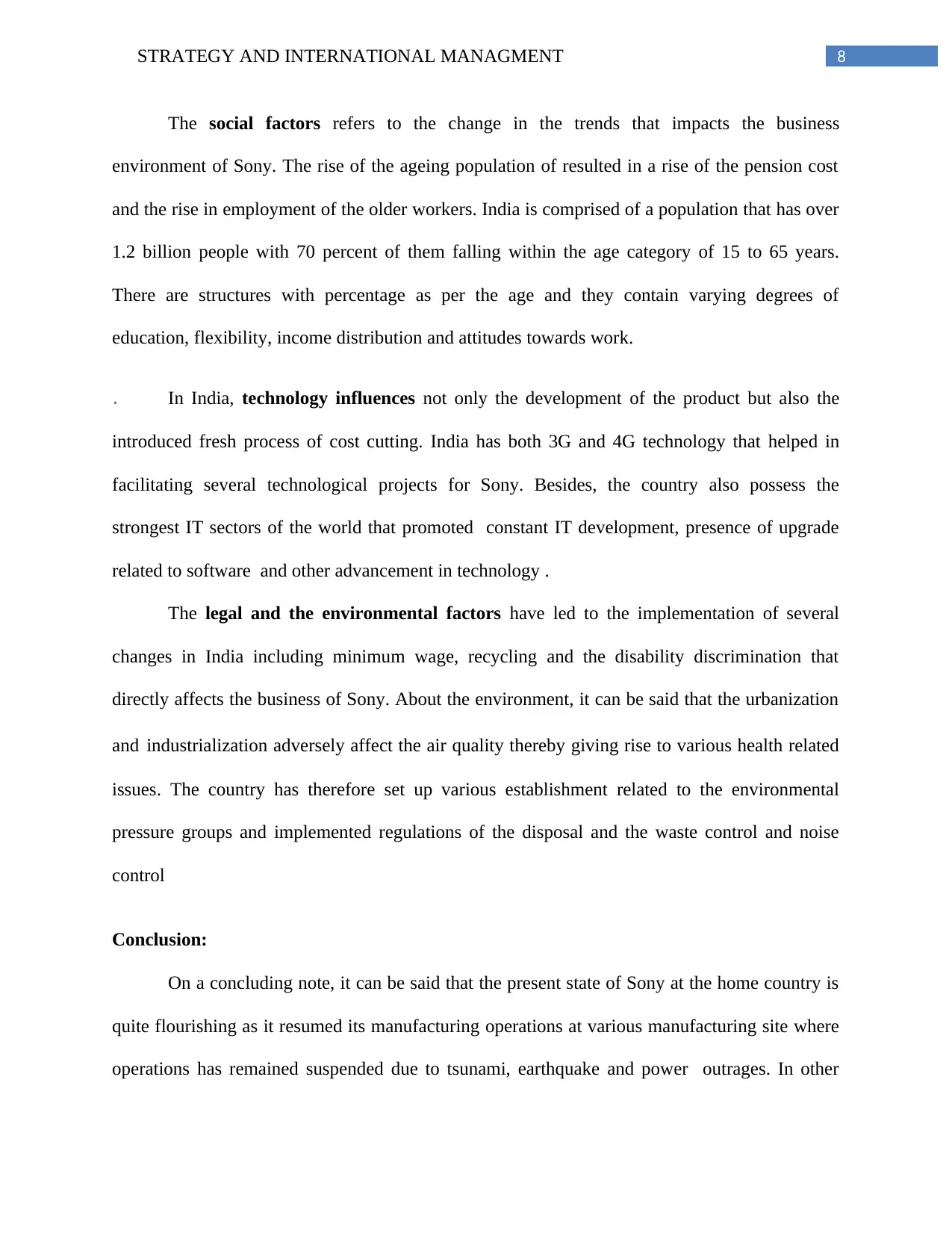
8STRATEGY AND INTERNATIONAL MANAGMENT
The social factors refers to the change in the trends that impacts the business
environment of Sony. The rise of the ageing population of resulted in a rise of the pension cost
and the rise in employment of the older workers. India is comprised of a population that has over
1.2 billion people with 70 percent of them falling within the age category of 15 to 65 years.
There are structures with percentage as per the age and they contain varying degrees of
education, flexibility, income distribution and attitudes towards work.
. In India, technology influences not only the development of the product but also the
introduced fresh process of cost cutting. India has both 3G and 4G technology that helped in
facilitating several technological projects for Sony. Besides, the country also possess the
strongest IT sectors of the world that promoted constant IT development, presence of upgrade
related to software and other advancement in technology .
The legal and the environmental factors have led to the implementation of several
changes in India including minimum wage, recycling and the disability discrimination that
directly affects the business of Sony. About the environment, it can be said that the urbanization
and industrialization adversely affect the air quality thereby giving rise to various health related
issues. The country has therefore set up various establishment related to the environmental
pressure groups and implemented regulations of the disposal and the waste control and noise
control
Conclusion:
On a concluding note, it can be said that the present state of Sony at the home country is
quite flourishing as it resumed its manufacturing operations at various manufacturing site where
operations has remained suspended due to tsunami, earthquake and power outrages. In other
The social factors refers to the change in the trends that impacts the business
environment of Sony. The rise of the ageing population of resulted in a rise of the pension cost
and the rise in employment of the older workers. India is comprised of a population that has over
1.2 billion people with 70 percent of them falling within the age category of 15 to 65 years.
There are structures with percentage as per the age and they contain varying degrees of
education, flexibility, income distribution and attitudes towards work.
. In India, technology influences not only the development of the product but also the
introduced fresh process of cost cutting. India has both 3G and 4G technology that helped in
facilitating several technological projects for Sony. Besides, the country also possess the
strongest IT sectors of the world that promoted constant IT development, presence of upgrade
related to software and other advancement in technology .
The legal and the environmental factors have led to the implementation of several
changes in India including minimum wage, recycling and the disability discrimination that
directly affects the business of Sony. About the environment, it can be said that the urbanization
and industrialization adversely affect the air quality thereby giving rise to various health related
issues. The country has therefore set up various establishment related to the environmental
pressure groups and implemented regulations of the disposal and the waste control and noise
control
Conclusion:
On a concluding note, it can be said that the present state of Sony at the home country is
quite flourishing as it resumed its manufacturing operations at various manufacturing site where
operations has remained suspended due to tsunami, earthquake and power outrages. In other
⊘ This is a preview!⊘
Do you want full access?
Subscribe today to unlock all pages.

Trusted by 1+ million students worldwide
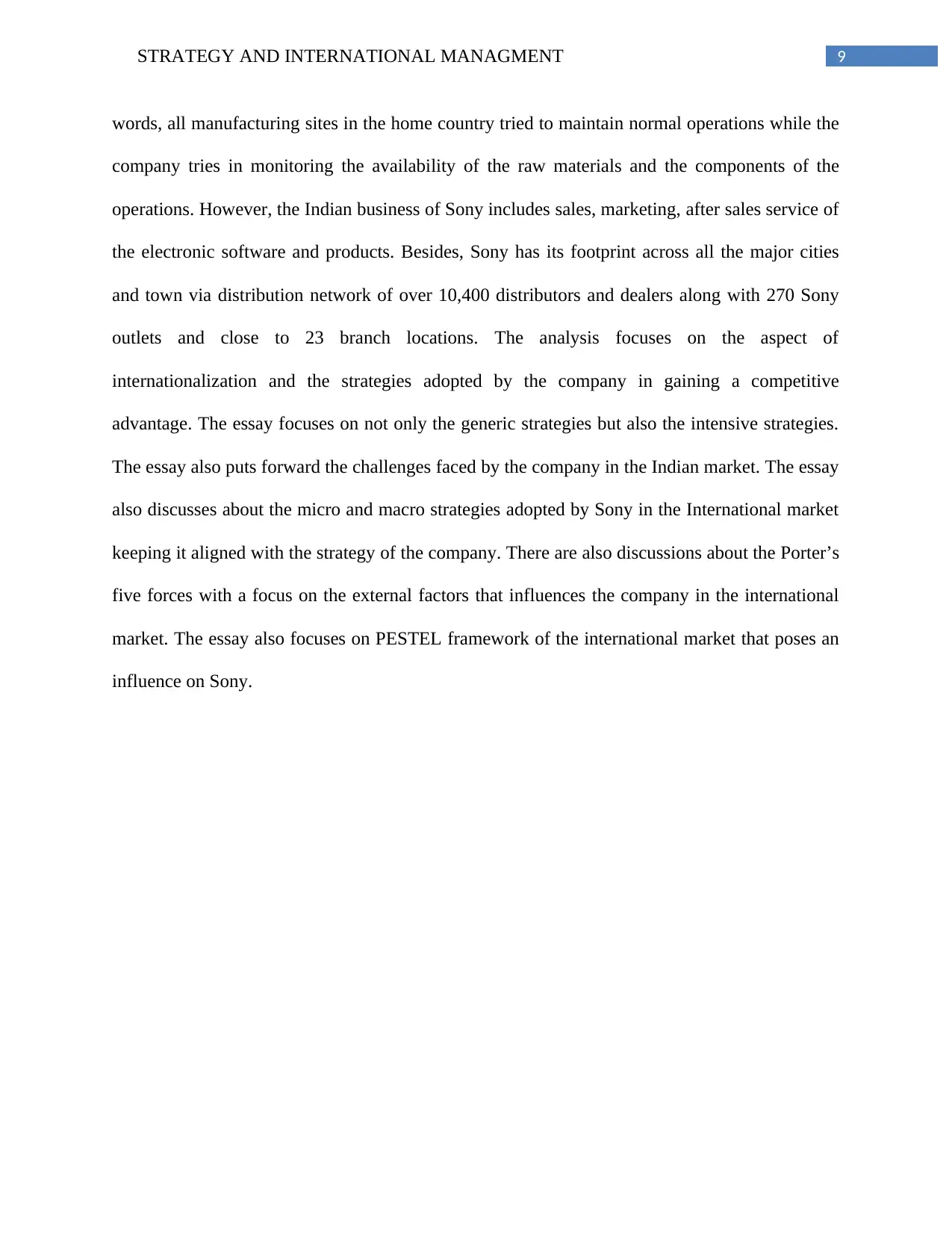
9STRATEGY AND INTERNATIONAL MANAGMENT
words, all manufacturing sites in the home country tried to maintain normal operations while the
company tries in monitoring the availability of the raw materials and the components of the
operations. However, the Indian business of Sony includes sales, marketing, after sales service of
the electronic software and products. Besides, Sony has its footprint across all the major cities
and town via distribution network of over 10,400 distributors and dealers along with 270 Sony
outlets and close to 23 branch locations. The analysis focuses on the aspect of
internationalization and the strategies adopted by the company in gaining a competitive
advantage. The essay focuses on not only the generic strategies but also the intensive strategies.
The essay also puts forward the challenges faced by the company in the Indian market. The essay
also discusses about the micro and macro strategies adopted by Sony in the International market
keeping it aligned with the strategy of the company. There are also discussions about the Porter’s
five forces with a focus on the external factors that influences the company in the international
market. The essay also focuses on PESTEL framework of the international market that poses an
influence on Sony.
words, all manufacturing sites in the home country tried to maintain normal operations while the
company tries in monitoring the availability of the raw materials and the components of the
operations. However, the Indian business of Sony includes sales, marketing, after sales service of
the electronic software and products. Besides, Sony has its footprint across all the major cities
and town via distribution network of over 10,400 distributors and dealers along with 270 Sony
outlets and close to 23 branch locations. The analysis focuses on the aspect of
internationalization and the strategies adopted by the company in gaining a competitive
advantage. The essay focuses on not only the generic strategies but also the intensive strategies.
The essay also puts forward the challenges faced by the company in the Indian market. The essay
also discusses about the micro and macro strategies adopted by Sony in the International market
keeping it aligned with the strategy of the company. There are also discussions about the Porter’s
five forces with a focus on the external factors that influences the company in the international
market. The essay also focuses on PESTEL framework of the international market that poses an
influence on Sony.
Paraphrase This Document
Need a fresh take? Get an instant paraphrase of this document with our AI Paraphraser
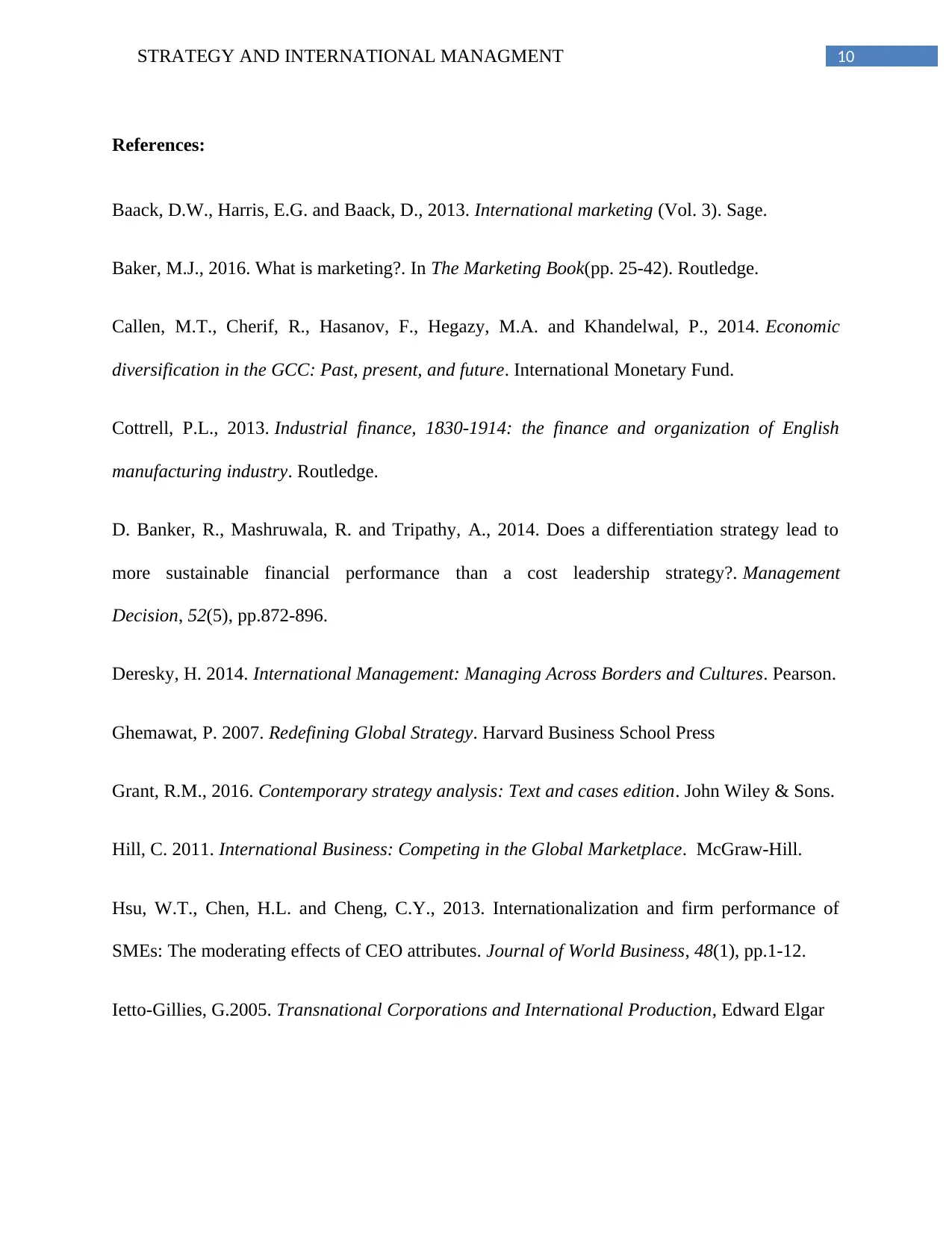
10STRATEGY AND INTERNATIONAL MANAGMENT
References:
Baack, D.W., Harris, E.G. and Baack, D., 2013. International marketing (Vol. 3). Sage.
Baker, M.J., 2016. What is marketing?. In The Marketing Book(pp. 25-42). Routledge.
Callen, M.T., Cherif, R., Hasanov, F., Hegazy, M.A. and Khandelwal, P., 2014. Economic
diversification in the GCC: Past, present, and future. International Monetary Fund.
Cottrell, P.L., 2013. Industrial finance, 1830-1914: the finance and organization of English
manufacturing industry. Routledge.
D. Banker, R., Mashruwala, R. and Tripathy, A., 2014. Does a differentiation strategy lead to
more sustainable financial performance than a cost leadership strategy?. Management
Decision, 52(5), pp.872-896.
Deresky, H. 2014. International Management: Managing Across Borders and Cultures. Pearson.
Ghemawat, P. 2007. Redefining Global Strategy. Harvard Business School Press
Grant, R.M., 2016. Contemporary strategy analysis: Text and cases edition. John Wiley & Sons.
Hill, C. 2011. International Business: Competing in the Global Marketplace. McGraw-Hill.
Hsu, W.T., Chen, H.L. and Cheng, C.Y., 2013. Internationalization and firm performance of
SMEs: The moderating effects of CEO attributes. Journal of World Business, 48(1), pp.1-12.
Ietto-Gillies, G.2005. Transnational Corporations and International Production, Edward Elgar
References:
Baack, D.W., Harris, E.G. and Baack, D., 2013. International marketing (Vol. 3). Sage.
Baker, M.J., 2016. What is marketing?. In The Marketing Book(pp. 25-42). Routledge.
Callen, M.T., Cherif, R., Hasanov, F., Hegazy, M.A. and Khandelwal, P., 2014. Economic
diversification in the GCC: Past, present, and future. International Monetary Fund.
Cottrell, P.L., 2013. Industrial finance, 1830-1914: the finance and organization of English
manufacturing industry. Routledge.
D. Banker, R., Mashruwala, R. and Tripathy, A., 2014. Does a differentiation strategy lead to
more sustainable financial performance than a cost leadership strategy?. Management
Decision, 52(5), pp.872-896.
Deresky, H. 2014. International Management: Managing Across Borders and Cultures. Pearson.
Ghemawat, P. 2007. Redefining Global Strategy. Harvard Business School Press
Grant, R.M., 2016. Contemporary strategy analysis: Text and cases edition. John Wiley & Sons.
Hill, C. 2011. International Business: Competing in the Global Marketplace. McGraw-Hill.
Hsu, W.T., Chen, H.L. and Cheng, C.Y., 2013. Internationalization and firm performance of
SMEs: The moderating effects of CEO attributes. Journal of World Business, 48(1), pp.1-12.
Ietto-Gillies, G.2005. Transnational Corporations and International Production, Edward Elgar
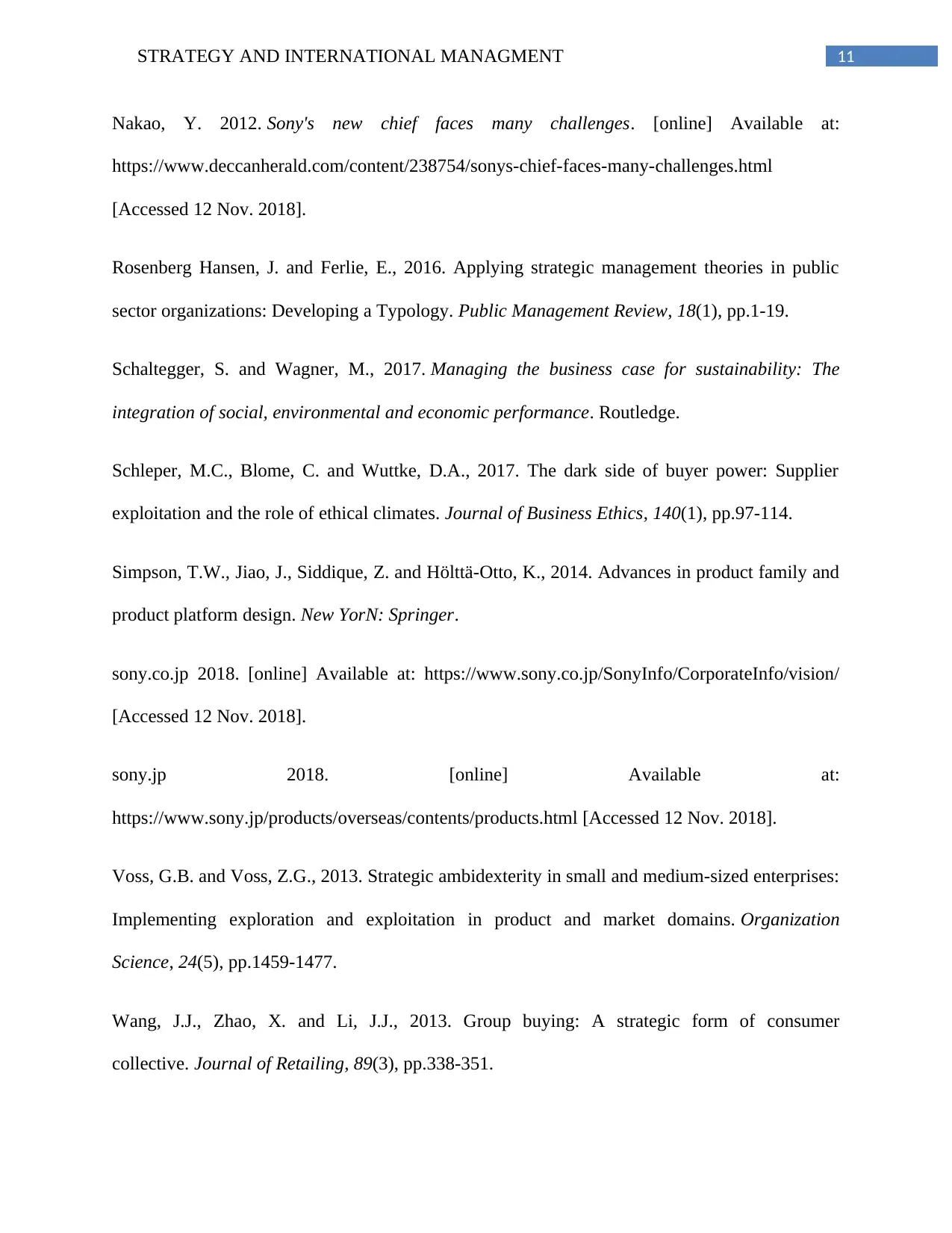
11STRATEGY AND INTERNATIONAL MANAGMENT
Nakao, Y. 2012. Sony's new chief faces many challenges. [online] Available at:
https://www.deccanherald.com/content/238754/sonys-chief-faces-many-challenges.html
[Accessed 12 Nov. 2018].
Rosenberg Hansen, J. and Ferlie, E., 2016. Applying strategic management theories in public
sector organizations: Developing a Typology. Public Management Review, 18(1), pp.1-19.
Schaltegger, S. and Wagner, M., 2017. Managing the business case for sustainability: The
integration of social, environmental and economic performance. Routledge.
Schleper, M.C., Blome, C. and Wuttke, D.A., 2017. The dark side of buyer power: Supplier
exploitation and the role of ethical climates. Journal of Business Ethics, 140(1), pp.97-114.
Simpson, T.W., Jiao, J., Siddique, Z. and Hölttä-Otto, K., 2014. Advances in product family and
product platform design. New YorN: Springer.
sony.co.jp 2018. [online] Available at: https://www.sony.co.jp/SonyInfo/CorporateInfo/vision/
[Accessed 12 Nov. 2018].
sony.jp 2018. [online] Available at:
https://www.sony.jp/products/overseas/contents/products.html [Accessed 12 Nov. 2018].
Voss, G.B. and Voss, Z.G., 2013. Strategic ambidexterity in small and medium-sized enterprises:
Implementing exploration and exploitation in product and market domains. Organization
Science, 24(5), pp.1459-1477.
Wang, J.J., Zhao, X. and Li, J.J., 2013. Group buying: A strategic form of consumer
collective. Journal of Retailing, 89(3), pp.338-351.
Nakao, Y. 2012. Sony's new chief faces many challenges. [online] Available at:
https://www.deccanherald.com/content/238754/sonys-chief-faces-many-challenges.html
[Accessed 12 Nov. 2018].
Rosenberg Hansen, J. and Ferlie, E., 2016. Applying strategic management theories in public
sector organizations: Developing a Typology. Public Management Review, 18(1), pp.1-19.
Schaltegger, S. and Wagner, M., 2017. Managing the business case for sustainability: The
integration of social, environmental and economic performance. Routledge.
Schleper, M.C., Blome, C. and Wuttke, D.A., 2017. The dark side of buyer power: Supplier
exploitation and the role of ethical climates. Journal of Business Ethics, 140(1), pp.97-114.
Simpson, T.W., Jiao, J., Siddique, Z. and Hölttä-Otto, K., 2014. Advances in product family and
product platform design. New YorN: Springer.
sony.co.jp 2018. [online] Available at: https://www.sony.co.jp/SonyInfo/CorporateInfo/vision/
[Accessed 12 Nov. 2018].
sony.jp 2018. [online] Available at:
https://www.sony.jp/products/overseas/contents/products.html [Accessed 12 Nov. 2018].
Voss, G.B. and Voss, Z.G., 2013. Strategic ambidexterity in small and medium-sized enterprises:
Implementing exploration and exploitation in product and market domains. Organization
Science, 24(5), pp.1459-1477.
Wang, J.J., Zhao, X. and Li, J.J., 2013. Group buying: A strategic form of consumer
collective. Journal of Retailing, 89(3), pp.338-351.
⊘ This is a preview!⊘
Do you want full access?
Subscribe today to unlock all pages.

Trusted by 1+ million students worldwide
1 out of 12
Related Documents
Your All-in-One AI-Powered Toolkit for Academic Success.
+13062052269
info@desklib.com
Available 24*7 on WhatsApp / Email
![[object Object]](/_next/static/media/star-bottom.7253800d.svg)
Unlock your academic potential
Copyright © 2020–2025 A2Z Services. All Rights Reserved. Developed and managed by ZUCOL.




